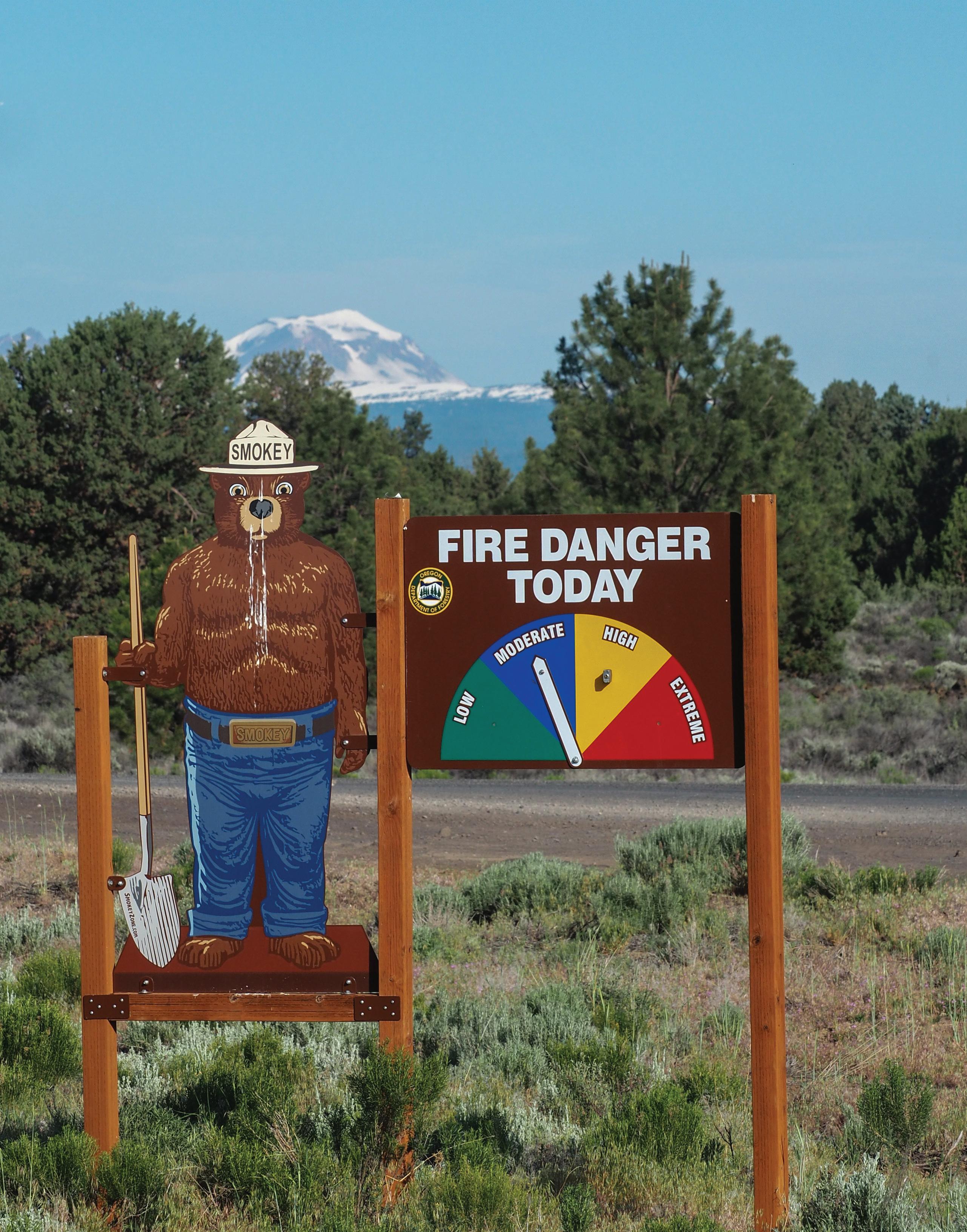






























July 2025 • Volume 72, No. 7
CEO Michael Shepard
SENIOR VP OF CONTENT Leon Espinoza
EDITORIAL DIRECTOR Chasity Anderson, CCC
DEPUTY EDITORIAL DIRECTOR
Noble Sprayberry
SENIOR EDITOR Jennifer Paton, CCC
ASSISTANT EDITORS Victoria Hampton, CCC; David Herder, CCC; Sable Riley, CCC
ASSOCIATE EDITORS
Valeri Saldanha Rosa, Nina Todea
PUBLICATIONS PRODUCTION SR. MANAGER
Elizabeth Beatty
SENIOR PUBLICATIONS COORDINATOR
Alyssa McDougle
Ruralite (USPS 397-460) is published monthly for members for $5.43 per year, plus postage, by Pioneer Utility Resources Inc., 5625 NE Elam Young Parkway, Suite 100, Hillsboro, OR 97124—a not-for-profit Oregon cooperative corporation—to serve the communication needs of 46 consumer-owned electric utilities in Oregon, Washington, Alaska, Idaho, Nevada and California. Preferred periodical postage paid at Hillsboro, Oregon, 97123 and additional mailing offices. © 2025 Pioneer Utility Resources. All rights reserved. Reproduction in whole or in part without written permission is prohibited.
Postmaster: Send address changes to Ruralite, 5625 NE Elam Young Parkway, Suite 100, Hillsboro, OR 97124-6454
HOW TO CONTACT RURALITE
Subscription services:
Nonmember subscriptions $15 (U.S.) per year; $25 per year (foreign). Prepayment required. Allow 4-8 weeks for first issue. Be sure to identify which local edition you want to receive.
Address Changes:
Utility members, contact your local utility. Subscribers, call us at 503-357-2105, option 3, or email mailingdept@pioneer.coop.
Back issues:
Back issues and extra copies are $3. Prepayment required. Supply is limited. Be sure to identify edition, month and year. Call first if ordering back issues to check availability.
To contact Ruralite: Ruralite magazine is published by Pioneer Utility Resources, P.O. Box 1306, North Plains, OR 97133-1306; 503-357-2105; email: info@pioneer.coop. For more information, visit pioneer.coop.
DISPLAY ADVERTISING INQUIRIES
American MainStreet Publications
611 S. Congress Ave., Suite 504 Austin, TX 78704
800-626-1181 or 512-441-5200

For supplemental and interactive content, search @Ruralite on your favorite social media sites.
Some people see something worth sharing and simply can’t walk away. This month’s stories celebrate individuals who have become keepers of what matters to them.
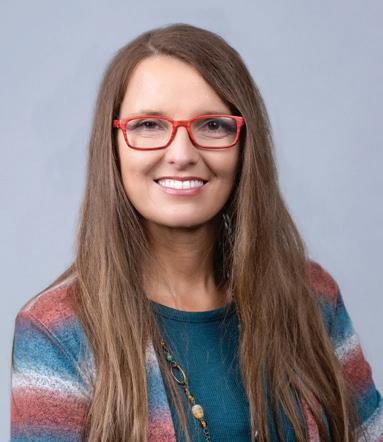
Michael Calhoun saw nature trails that shaped his childhood and refused to let their significance go unrecognized. Through years of paperwork and advocacy, he secured National Recreation Trail designations for the Crown Zellerbach and Banks-Vernonia trails—not for personal gain, but because he understood these paths deserved their place on the map. “It highlights what’s unique in your own backyard,” he tells us, recognizing that sometimes the most precious things are hiding in plain sight.
Keith Lionetti and Paul Stiller took that same protective instinct and built something lasting with their disc golf courses. What started as personal passion evolved into spaces where others can discover the joy they find in the sport.
Dave LaBelle’s photography column reminds us that sometimes preservation is as simple as being present with our camera when relief
arrives—capturing those fleeting moments when heat gives way to coolness, when discomfort transforms into gratitude.
What strikes me about these stories is how naturally caring leads to sharing. Michael didn’t stop at enjoying his hometown trails—he worked to ensure others could discover them, too. Keith and Paul didn’t just play disc golf—they created spaces where the sport could flourish. None of these keepers are hoarding their treasures. They’re multiplying them.
As summer reaches its peak, I find myself wondering what I’m keeping safe for others. Is it a family recipe that deserves to be passed down? A local tradition that needs an advocate? A skill that could benefit someone once its shared? Sometimes the most meaningful work we do isn’t creating something new but ensuring something valuable doesn’t disappear.
The keepers in our communities understand preservation isn’t about freezing things in time—it’s about creating pathways for others to experience what we’ve found meaningful. They know the best way to honor what we love is to make sure it survives and thrives beyond us.
Until next time,
Chasity Anderson Editorial Director

One man’s mission highlights hidden gems Up Close, Page 10
Disc golf’s popularity soars Spotlight, Page 12
Guide to summer mocktails In the Kitchen, Page 16
Electricity powers our lives. We depend on it for nearly everything we do. Central Electric Cooperative understands how frustrating it can be when you are without it. The most familiar phrase we hear during an outage is, “How long will it take?”
We understand. It can take time, but our line crews won’t rest until they fix the outage, following a prioritized restoration process to ensure their safety and the safety of our members and their communities.
Power outages are never convenient and happen for various reasons:
Planned maintenance or upgrades. CEC invests heavily in strengthening its infrastructure all year to improve system resiliency and maintain the mission of providing safe, reliable power to its members.
Central Electric Cooperative sometimes schedules outages to upgrade equipment or perform maintenance. While inconvenient, these outages are necessary to prevent larger, unplanned disruptions.
When CEC plans an outage, it first contacts affected members to inform them when the outage will occur and how long it will last.
However, members aren’t always aware. Ensure your contact information is current with CEC to help us communicate more effectively with you.
Severe weather events. In Central Oregon, winter and summer storms are the leading cause of power outages. High winds, snow, ice, heavy
rain and lightning can damage power lines, poles and substations. During storms, falling branches, trees or other foreign objects may make contact with power lines, leaving neighborhoods in the dark.
Equipment failure. Like your appliances at home, our equipment can unexpectedly fail. While CEC routinely patrols its power lines and inspects equipment for damage to minimize failures, they can still occur, requiring crews to locate and make repairs when they happen.
Animal interference. Occasionally, small wildlife—such as squirrels or birds—find their way into a substation or transformer, inadvertently causing power disruptions. It’s a common occurrence and challenging to prevent.
Human error or accidents. Construction work, digging into underground power lines or vehicles colliding with utility poles are common human-related causes of power outages.
When an area we serve is at high risk for wildfire, it may require us to proactively

deenergize power lines to protect a community. A PSPS is a last resort safety measure tool. It is implemented in extreme circumstances, such as weather-related red flag warnings or in an emergency when public safety officials request us to deenergize a line during a threatening event to protect human life, homes and structures.
Restoring power after an outage is a coordinated effort involving specialized personnel, advanced technology and clear prioritization, with safety being the highest priority. When CEC receives notice of outages, key personnel

involved in the restoration process are alerted.
1. Assessing the damage. The process begins with identifying the cause of the outage. CEC uses outage management systems and smart-grid technology to pinpoint the affected areas. Field crews then look for, find and determine the necessary steps to make the repairs safely.
2. Prioritizing repairs. Restoration efforts prioritize critical infrastructure, such as hospitals and emergency services. Next, they focus on areas with the most affected members.
3. Repairing or replacing equipment. Crews repair downed power lines and replace damaged transformers and poles as needed. Following severe damage, rebuilding parts of the grid may be required, which can extend restoration times.
4. Reenergizing. Before restoring power, crews make needed repairs to ensure everything works correctly and safely,
including inspecting each affected section of the line. Depending on the situation, crews might have to restore the power incrementally to avoid overloading the grid. These safety precautions may extend outage time.
5. Communicating with memberowners. Throughout the process, CEC’s member services team updates local media and members via its website, cec.coop, and social media, like Facebook and X. Additional communication is issued for prolonged outages and PSPS.
Restoring power is not without its challenges. Adverse weather may make it impossible to begin repairs right away.
With 5,300 square miles of service territory, outages occur in remote areas, requiring additional time for crews to get to the location.
CEC’s line crews often face severe conditions, including heavy snow, high

winds and extreme temperatures, while repairing damage and restoring power.
When a power outage occurs, CEC prioritizes restoring your power as safely and efficiently as possible. To help, call CEC to report an outage at 541-548-2144.
To help prevent outages, members can notify us when they see birds building a nest on a power pole or vegetation encroaching power lines and stay alert when working or playing near electrical equipment.
Most importantly, if you see downed power lines, stay back and call 911 or CEC right away.
Power outages happen. Knowing what causes them and the work involved in restoring power helps everyone understand the process. While we can’t always give an exact timeline, our crews work safely to get the lights back on. n
By Allison Hamilton and Jennifer Paton
Data centers are the backbone of the internet. They store and manage everything from social media to cloud computing and artificial intelligence to streaming services.
As more people and businesses go digital, the number of data centers is quickly growing. While many of these centers were once built near large cities, more are now sited in rural areas. Electric utilities receive regular requests from companies looking to build large data centers in their service territories. These requests present significant opportunities and substantial challenges.
Umatilla Electric Cooperative, based in Hermiston, Oregon, has a front-row seat. Since energization of the region’s first data center, UEC’s service territory on the eastern side of the state has experienced significant growth. In 2013, UEC’s system peak demand was 224 megawatts. That number has climbed sharply in the years since, reaching a new system peak of 1,405 MW in June 2025.
“While data centers have played a role in driving growth, they are not the sole contributor,” UEC Assistant General Manager Josh Lankford says. “Over the past decade, we’ve also seen steady expansion in other industries across the region. But being a ‘new’ industry, it has had a ripple effect—bringing in new jobs, attracting people to relocate, and fueling demand for housing and construction.”
Why are data centers coming to rural areas?
As UEC has experienced, there are several reasons why companies are choosing rural locations for their data centers:
• More land. Rural areas have plenty of space for large buildings.
• Resource diversity. Public power utilities provide electricity from reliable
sources of energy. While early data center siting teams may have initially focused on access to reliable, low-carbon hydropower and the availability of industrial-zoned land, Josh says successfully serving large-load members in UEC’s region has required broad collaboration.
“As a utility, we’ve adopted a solutionsoriented mindset—approaching challenges with ‘How can we make it happen?’ We’ve had to align realistic construction timelines with long-term load growth and financial planning to confidently engage with planning commissions, city governments and contractors.”
• Lower costs. Land and labor are usually less expensive outside of cities.
• Tax breaks. Local and state governments may offer tax benefits to attract these businesses.
also improve service for all consumers by making the electric system stronger.
• Community impact. “Beyond their operational footprint, data centers have had a measurable and positive impact on our local communities,” Josh says. “Their presence contributes substantially to the tax base, supporting schools, emergency services and other essential public resources.”
He says these companies have also demonstrated a strong commitment to philanthropic giving—funding educational programs, workforce development and community initiatives that align with the region’s values.
While data centers create significant opportunities for electric utilities by driving demand and investment, they also
It’s a dynamic environment—but one that we continue to navigate with an eye toward resilience, equity and sustainability.
— Umatilla Electric Cooperative Assistant General Manager Josh Lankford
Data centers can be huge, sometimes requiring more electricity than all a utility’s current consumers combined. This increased demand for electricity brings several new opportunities for utilities.
• New jobs and growth. Data centers can bring jobs and revenue to small communities.
• Stable revenue. The centers require a lot of power and usually sign long-term contracts. This provides an electric utility with steady income, which can help pay for system upgrades and keep rates lower.
• Improved infrastructure. To serve a large data center, an electric utility might need to build new power lines or substations. While this is expensive, it can
present challenges in meeting increased electricity needs while maintaining reliable and resilient power delivery.
• High up-front costs. Building the new infrastructure to power a data center can cost millions, which is why electric utilities work diligently with data center customers to ensure upfront costs are covered.
• Risk of losing a big customer. If the data center moves away or shuts down, the utility could be left with expensive equipment it no longer needs. This could negatively affect the utility’s finances.
• Permitting and siting. Acquiring permission to build new power lines and substations takes time. There may be zoning rules, environmental reviews and public meetings that slow things down.
At UEC, the pace and scale of growth associated with large-scale data center development have pushed the utility to meet aggressive schedules, often on compressed timelines.
“Delivering on these commitments demands a workforce that is not only highly skilled but also available when we need them—a challenge in itself as we compete to recruit and retain top-tier talent across engineering, operations and financial planning disciplines,” Josh says.
Josh points out that uneven growth across member categories affects every level of the organization.
“It has impacted board-level responsibilities and required us to adapt quickly to emerging regulatory and compliance challenges,” he says.
• Securing enough electricity. Sourcing adequate power to meet these escalating demands can require innovative thinking and new contractual approaches.
“We’ve had to secure power through creative and forward-looking agreements
to ensure reliability without compromising service to our existing members,” Josh says. “At the same time, we are steadfast in our commitment to fairness—ensuring that those driving growth are also responsible for covering the costs of the infrastructure required to serve them.”
To manage the risks and rewards associated with data centers, electric utility leaders are taking a careful, informed approach. They are working closely with their generation and transmission providers, economic development offices and financial experts to plan these projects.
Josh says as the utility’s communities grow, so does the need for resilient infrastructure. But UEC has found ways to meet this challenge.
“We have invested in critical system upgrades, including modern meter equipment, new transmission and distribution lines and have both expanded or rebuilt much of our substation capacity,” he says.
“These projects are essential for preventing service interruptions and accommodating future growth, ensuring we stay ahead of demand while maintaining reliability.”
Utilities also ensure contracts with data center operators include protections for the utility. For example, if the data center leaves early, it may be liable for paying part of the infrastructure costs.
Forecasting tools help utilities understand how the new load will affect the local system.
“Balancing these demands while upholding our cooperative principles has reinforced the importance of longterm planning, strategic partnerships and thoughtful growth management,” Josh says. “It’s a dynamic environment—but one that we continue to navigate with an eye toward resilience, equity and sustainability.”
By asking the right questions and building smart partnerships, electric utilities are well-positioned to make informed decisions that serve their members well—now and in the future. n

By Courtney Cobb
It’s been a busy season of cat rescues for Central Electric Cooperative Serviceman Chris Laite. In May, Chris was dispatched to a member’s home to rescue a wayward cat who had managed to get to the top of a power pole with a transformer. The owner called Central Electric Cooperative to ask for help.
Chris says when he arrived at the property, the owner told him the cat had been up there for about a day and a half. Proceeding with caution and safety, Chris disconnected the power on the single-span tap to the transformer to protect himself and the cat.
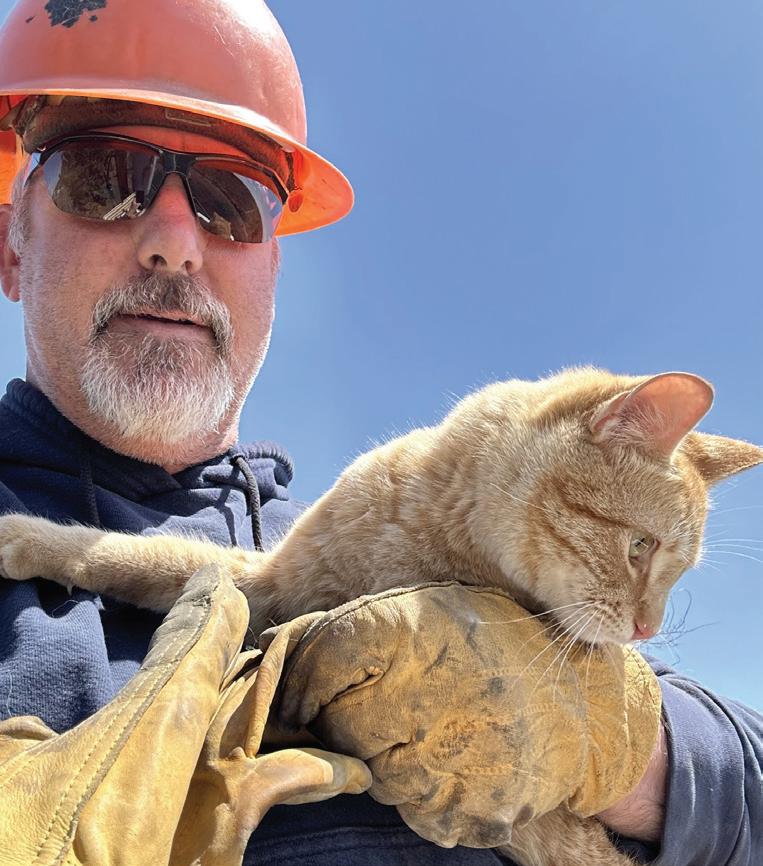
“I decided to do that just in case he decided to go crazy,” Chris says with a laugh.
The owner said the cat was friendly, but having rescued felines before, Chris took one more protective measure—a sweatshirt. This way, he would be covered if claws came out during the ride down.
Chris says the cat eyed him warily as he approached in his bucket but cautiously sniffed his hand when he got near enough to rescue him.
“He sniffed my hand, looked at me, and I reached over and picked him up,” he says. “I took a picture with him because he was the first cat that ever waited for me to arrive.”
No stranger to rescues, Chris says cats often become skittish and jump down or to the nearest object.
With the furry bundle tucked in his arms, Chris moved down the boom.
“I will admit (the cat) started questioning what was going on as we moved down,” he says. “That’s when the dew claw came out, and he held on.”
Once safely back on the ground, Chris handed the cat to the grateful owner.
The cat is safe, and CEC has received no further reports of him trying to climb up any power poles. n







































By Vicki Hillhouse
mission
Five years ago, a colorful marker caught Michael Calhoun’s eye as he set out for a hike on an Oregon Coast trail. The sign identified the path as a National Recreation Trail. Curious about its meaning, he searched the designation online, learned about the program and immediately thought of two trails near his Vernonia community deserving of their own markers.
In 2023—after a lot of paperwork, meetings and Michael’s advocacy with various agencies—the Crown Zellerbach
Trail received the National Recreation Trail designation from the U.S. secretary of the interior. One year later, he helped secure the same designation for the BanksVernonia State Trail.
This summer, Michael intends to celebrate with a joint dedication ceremony for both places.
The national recognition stands to bring increased publicity to the trails, along with the prestige of being part of the National Trails System network. More than 1,300 trails strong, the network helps nature lovers discover new places
to explore. National Recreation Trail designations can also boost state and federal funding opportunities.
“It’s kind of like a credential,” Michael says.
For him, there’s a deeper significance—it highlights the story of the rural area where he was born, raised and learned just about everything he knows about nature.
“That’s what I think is so cool about this whole program,” he says. “It highlights what’s unique in your own backyard. There are hidden gems to be discovered and used.”
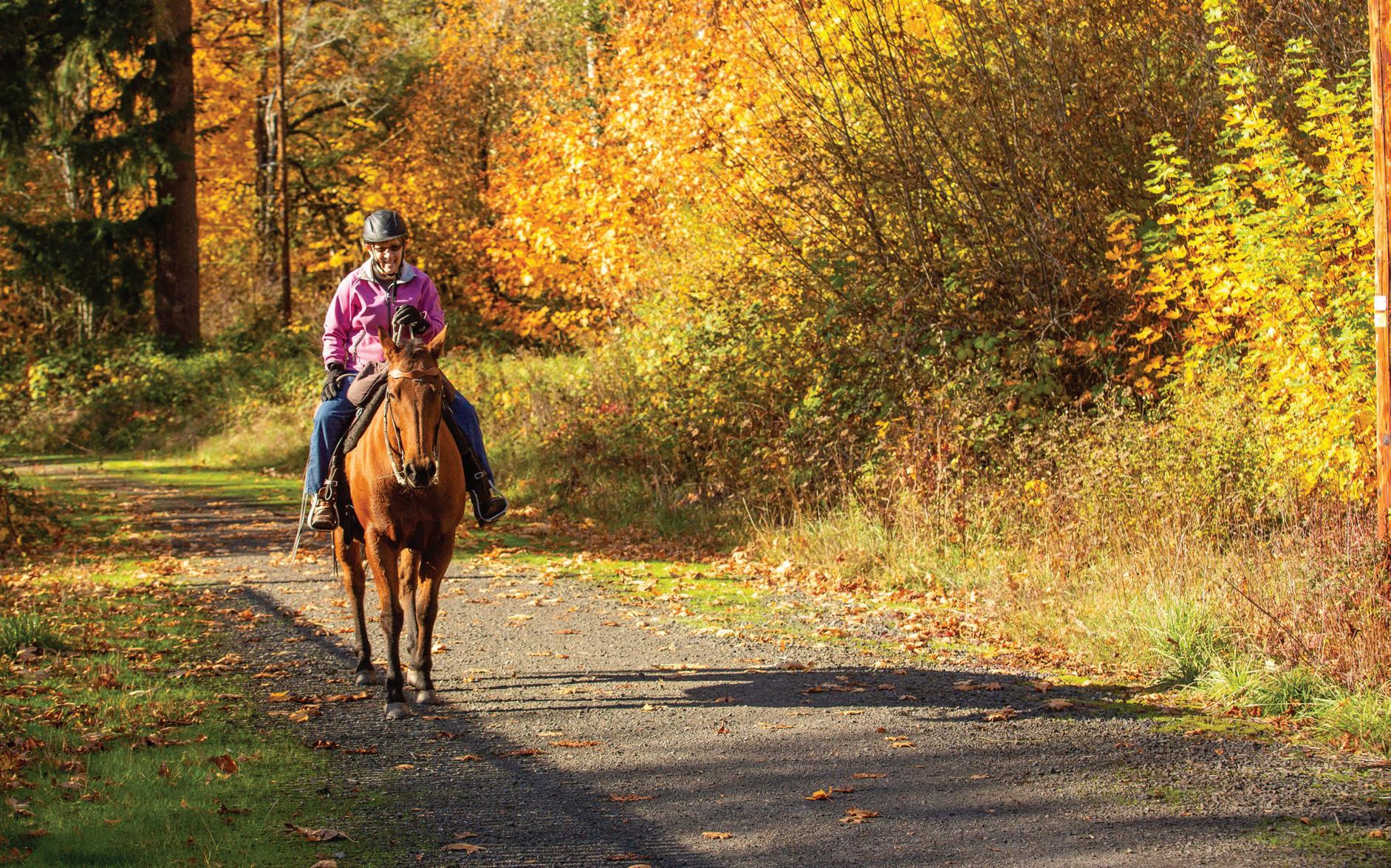
Known locally as the CZ or Crown Z Trail, the Crown Zellerbach is a 22-mile trail connecting Scappoose and Vernonia through the wetlands of the Columbia River and the forested foothills of the state’s coastal range. It mostly follows the gentle grades of a logging railway that was ultimately widened for logging trucks.
The right of way is now property of Columbia County, which opened the trail to the public in 2014. The trail has nine trailheads, 23 interpretive kiosks and welcomes hikers, bicyclists and equestrians.


Michael’s appreciation for history and geography was instilled at a young age by his parents, Steve and Carol Calhoun. Inspired by the Back to the Land movement, the family focused on the simplicity and beauty of rural living. Their home was a log cabin next to Rock Creek, the source of the town’s drinking water.
A tiny Michael, ushered by his parents to gaze at the night sky, is said to have uttered his first sentence—something about the moon—on the banks of Vernonia Lake. The waterway, which was the town’s former mill pond, loops to the Banks-Vernonia State Trail where he learned to ride a bike and later trained for track and cross-country.
That’s also when he started honing some of his early leadership skills. As a high school student, Michael attended the Youth Energy Seminar Camp in California through West Oregon Electric Cooperative. After graduating, he went on to Western Oregon University, earning a communications degree.
He spent the rest of his 20s away from his hometown, completing an additional degree in environmental studies at the University of Oregon before returning home during the pandemic to focus on conservation and environmental activism.
“I think that’s common for a lot of people when they grow up in a rural area—they want to get out and see the world,” he says. “You get to experience things, but you also realize how special your hometown is.”
These days, he often trains on the trail for marathons, trekking across the 21-mile path’s 13 bridges. The trail follows the town’s 1920s-era railway line, which made it Oregon’s first Rails to Trails park.
“I still try to get out to it as much as I can,” Michael says. “What I like about it is it’s got its own beauty at different times of the year.”
Winter’s thick coats of moss give way to spring blossoms. Summer is his favorite— before the leaves turn, and while the lush canopy serves as a shield from the sun’s rays.
“I’m really proud of my hometown and what it’s done for me,” he says.
Preserving the history and nature of Vernonia and the surrounding areas has become a passion. When the Greenman Field grandstands fell into disrepair, Michael joined the Grandstand Committee to save and revitalize the historic structure.
Between that and the trail designations, he’s just warming up.
The 21-mile paved rail-to-trail path connects Banks and Vernonia through the foothills of Oregon’s lush coastal mountain range.
Owned by the Oregon Parks and Recreation Department since 1990, it includes an 8-footwide hiking and biking trail alongside a 4-foot-wide gravel trail to accommodate horses. It features 13 bridges and winds through Washington and Columbia counties.
The south end begins in Banks, surrounded by agricultural operations, heads through fields and riparian areas before reaching the thickly forested foothills of the coastal range. It ends in Vernonia surrounded by small farms and timberland.
Information from the National Park Service and U.S. Forest Service.
“Anyone else who knows of a trail that’s special to them can seek out and try for certification, too,” he says. “The trail could be a few feet long or a couple hundred miles long.”
Michael says any trail that is unique or special—so every trail—could be designated.
“As long as you have an advocate who can apply.”
For information on the trail dedication ceremony, contact Michael Calhoun at mcalhoun11@mail.wou.edu or 503-704-7837.
X The National Recreation Trail program was created by the National Trails System Act of 1968.
X Trails must be approved through an application and review process before being designated by the secretary of the interior each June.
X As of 2024, there were 1,348 National Recreation Trails and National Water Trails.
X National Recreation Trails are in all 50 states, plus Puerto Rico and Washington, D.C.
X The combined length of the trails is more than 30,000 miles.
X The shortest National Recreation Trail is the Forest City Trail in Tennessee, at just one-tenth of a mile.
X The longest trail is the Florida Circumnavigational Saltwater Paddling Trail, at 1,500 miles.

On the first Saturday in August, sports enthusiasts around the country celebrate National Disc Golf Day. With more than 10,000 courses spread across the country, there are plenty of places to join in the fun.
Most disc golf courses are on public land in parks and forests, and everyone is welcome to try their hand at the game. Players launch a disc from a tee area and try to land it in a hanging basket “hole” in as few throws as possible. With trees, shrubs, ponds, rivers and even dramatic elevation variations along the way, this is no simple task.


“It’s pretty cheap to get into,” says Paul Stiller, founder of Caliber Disc Golf Course in Idaho. “A lot of places are free to play. You can pick up a disc for about $8, and you’re off and going and having fun in the park and getting exercise.”
Keith Lionetti, co-founder of Kayak Point Disc Golf Resort in Washington, says it’s all about accessibility.
“It’s fairly easy to pick up, and if not, we give lessons,” he says. “If you’ve thrown a Frisbee, you can play disc golf.”
For many players, the sport becomes a healthy addiction.

“You can get into it,” Keith says. “You can
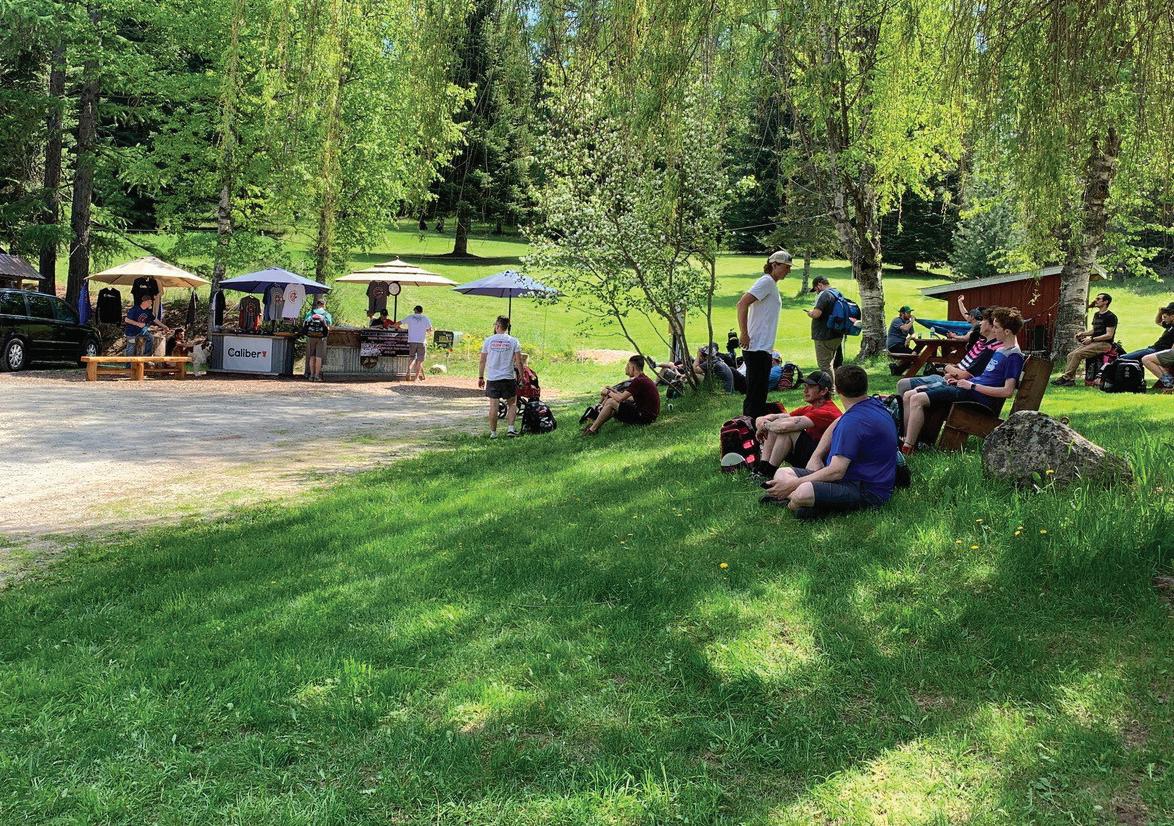
Keith was reluctant to try the sport.
“I thought it was kind of weird at first,” he says. “I was—and am still—kind of an introvert.”
Finally, he thought, “You know what, I’m going to try this.”
A friend took him out to play a round, and Keith was hooked.
“I just fell in love with it,” he says. “It’s something cool to do to get out and walk around and try to throw a disk of plastic at shiny things.”
Though some say similar games were played as early as the 1920s in Canada, the sport as it’s known today took flight in 1975, thanks to the father of disc golf, former Wham-O Vice President Ed Headrick.
Working in the toy business, Ed saw endless potential for flying discs. As a guest on "The Tonight Show” he introduced Johnny Carson to the Frisbee and played catch with Ed McMahon. He explained the toy was inspired by Princeton students who tossed around lids from the Frisbie Pie Company’s cookie jars.
Ed is credited with refining the Frisbee for competitive play, inventing the target baskets still used today and installing the
The sport meant so much to Ed that after he died in 2002, his family carried out his wishes and had his ashes incorporated into a limited-edition press of 4,000 Discraft flying discs. Most of the discs were given to friends and family, but some were sold to benefit a nonprofit memorial museum.
The sport Ed launched continues to grow with courses popping up all over the world.
The Pacific Northwest, West Coast and Intermountain West are home to some of the highest-rated courses on the planet. Paul’s course, Caliber Disc Golf Course, was ranked fifth in the world on the 2025 list by disc golfer app UDisc. It ranked in the top eight each of the last four years. The top three courses on the list are in Norway, Sweden and Finland, where Paul says the sport is revered.
“When I invest in my course it’s tens of thousands," he says. "When they invest it’s hundreds of thousands or millions."
Other regional courses to make the top 100 include BuckSnort in Pine, Colorado, which came in at 16. Beaver Ranch Disc Golf Course in Conifer, Colorado, ranked 20th; and Bear Mountain in Bailey, Colorado, at 32. One of Keith’s courses,


Low, Arizona, 73; Milo McIver (East) in Estacada, Oregon, 85; DeLaveaga Disc Golf Course in Santa Cruz, California, 88; Base Camp Adventure in Moab, Utah, 91; Whistler’s Bend in Roseburg, Oregon, 93; and Makoshika State Park-Buccaneer Flats in Glendive, Montana, 98.
Many of the highest ranked players in the world hail from the area, too. Women from the region breaking into the top 20 in the world include Ohh Scaggins, of Los Angeles, who is ranked No. 4; Ella Hansen, of Seattle, at fifth; Hanna Huynh, of Spokane, Washington, at 12th; and Jessica Weese, of Grass Valley, California at 20th.
On the men’s side, Anthony Barela, of Scottsdale, Arizona, is ranked No. 2. Anthony broke into the professional ranks as a 17-year-old playing alongside his idols in the Beaver State Fling. Richard Wysocki, also of Scottsdale, is ranked fourth; and Eagle McMahon, of Boulder, Colorado, is 16th.
Turning Pro
But can you make a living playing disc golf?
“This is what’s crazy,” Keith says. “Nowadays you can. There are players that that’s all they do, and they make a decent living.”
Paul says some are making big money.

“There’s guys who sign contracts for five years, $5 million; 10 years, $10 million, and that’s not even other sponsorships,” he says. “That’s just to throw discs for those companies. And then you get the shoes, and you get the clothes, and you go win the tournaments. It’s growing. Someday we’ll be as popular as bowling, and guys will be making $40,000 or $50,000 a win. But they’re working up into the $20,000 and $30,000 range, which is good compared to 10 years ago when it was $1,200.
“If you are a top player, and you can excel, there’s definitely a future for you,” Keith says. “The challenge is, that field is very competitive.”
To be competitive, Keith says core muscle building and practice are helpful.
“But you don’t need a lot of muscle tone,” he says. “Size isn't necessarily a factor,” he points out.
One of the best women in the world, he says, is maybe 5 feet tall and 100 pounds and able to outplay men who tower over her.
Keith says luck is part of the play, but only to a point.
“To be consistently good you’ve got to work at it or just be a natural,” he says. “Some people are just naturals. It’s incredible how the younger generations just keep getting better and better.” n
Kayak Point Disc Golf Resort in Stanwood, Washington, was a dream project years in the making. Co-founder Keith Lionetti ran a pro shop inside a public park for 15 years. As the sport grew, so did the number of visitors to the park.
“Every summer, the crowds kept getting bigger,” he says.
He longed for a dedicated space “out in the middle of nowhere.”
“I had been bugging the parks department,” Keith says. "Just one property, one disc golf course, didn’t matter if it was nine holes, doesn’t have to be 18 holes, could have been three holes, 1 acre, didn’t matter. I just kept bugging them.”
The local tourism bureau pushed, too, hoping to draw visitors to the area. Keith was scoping out another property when the county approached him about Kayak Point.
The 300 acres Kayak Point operates on was bought in the early ’70s by the Recreational Conservation Organization out of Olympia, Washington, and turned over to Snohomish County Parks & Recreation with the stipulation the land be used for golf.
For years it was used for “ball golf,” as Keith calls it.
“You know I’m a total disc golf nerd if I call it ball golf, right?” he jokingly asks.
With the traditional golf course operators struggling and the land overgrown, the parks and rec department considered tearing down buildings on the property.
“But the reality is it can’t be used for anything other than golf,” Keith says. “We were sweating bullets thinking, ‘Do you consider disc golf golf?’ And they did.”
That was in 2020. Since then, Keith and his team, including co-owner Eric Edgerton, built the course into a destination that ranks 20th in the country with a restaurant, pro shop and education building. Kayak Point’s courses routinely occupy three of the top five spots on the udisc.com top course list for Washington.
Kayak Point offers a mix of challenging courses for players of all skill levels. The Purple Course, catered to true beginners, is built on the bones of an old putting course with natural obstacles, ponds and even a lazy river along the way. The 18 holes wrap around the clubhouse and are free to play.
“My kids play it and have played it since they were 5,” says Keith, whose children are now 11 and 17. “If you’re a top touring pro, you could try to get an ace on every hole. It’s still not easy.”
Tee times and passes are required to access the remaining courses. The Green Course caters to novice players, the Red Course and soon-to-be completed White Course are intermediate, the Blue Course is advanced, and the Gold Course is designed for professionals.
An Idyllic Course in Idaho
Idaho’s Caliber Disc Golf Course and founder Paul Stiller’s new 18-hole course, Motherlode Disc Golf Course, are unique in that they’re built on private land, which eliminates some of the risks of developing on loaned or leased land.
“You know the story of disc golf is you get some land, a bunch of guys get together, they build a course, and then the piece of land gets taken away either by the county or the city or the donor of the land,” Paul says. “So, the only way to really go for it is to own your own property and do it. I just turned myself loose and said, ‘OK, honey, this is the last cockamamie idea I’ll have, but it’s going to work.’”
And it did work if Caliber’s ranking as the fifth-best course in the world is any indication.
Paul says his wife and three children have been supportive, even though he literally never leaves work. Neither do they—the family lives there in a house he’s thinking of turning into a clubhouse.
“It has views looking at five or six disc golf holes,” Paul says. “So, when you have tournaments it’s pretty big fun.”
Getting the course open each spring is challenging with all the tree litter cleanup. After it’s open, Paul says maintaining it is easier. In fact, he even gets a chance to play a few rounds a week.
Growing up in Ohio, Paul played traditional golf. He picked up disc golf in 1986 and played in Alaska, Oregon and Idaho. He doesn’t see much of a rivalry between ball and disc golfers. He knows others who play both sports, but most people pick one.
“I know disc golfers who are like, ‘Nah, I’m never going to swing a club,’ and I know golfers who would never stoop so low as to throw a disc,” he says. “But we get a lot of converts because golf is tough.”
So is disc golf, Paul adds, but he’s having fun.
“I never knew I was going to be doing this 10 years ago,” he says. “But I couldn’t see it any other way now. You know how sometimes you get a curveball, and you just have to go with it.” n


By Anne Braly
Alcohol-free beverages don’t have to be boring. They can be so flavorful you may rethink your idea of the afternoon cocktail—you may not even catch that the alcohol is a no-show.
Ice cubes
6-ounce can pineapple juice
6 ounces coconut milk
3 limes, juiced
2 tablespoons almondflavored syrup
1 cup club soda, or as needed
4 pinches ground nutmeg
4 lime wheels
4 sprigs fresh mint
Whether it’s due to the rise of the mindfulness movements like Dry January and Sober September, not to mention alcohol-free happy hours, consumers are demanding more thoughtful
Place a few ice cubes in a pitcher. Add pineapple juice, coconut milk, lime juice and almond-flavored syrup. Stir until chilled.
Strain mixture and pour it into four glasses. Top each glass with club soda.
Dust each mocktail with nutmeg. Garnish with a lime wheel and a sprig of mint.


beverages year-round.
So go ahead, take the plunge and have a mocktail party this summer. Here are some recipes that offer a cooling change for alcohol-free summer sipping.
4 cups strawberries, sliced 1 cup white sugar
8 cups cold water, divided
5 cups ice for serving, or as needed
1 lime, cut into 8 wedges
8 fresh mint sprigs
Mix strawberries, sugar and one cup cold water in a medium bowl. Cover the bowl with plastic wrap, and place in the refrigerator for 4 hours.
Pour chilled strawberry mixture into a blender. Blend on high until smooth. Pour through a wire mesh strainer set over a large bowl; discard pulp and seeds. Stir remaining 7 cups cold water into strawberry juice until it is well combined.
Fill eight glasses with ice. Pour strawberry mixture over ice. Garnish each serving with lime wedges and mint leaves.






2 2-liter bottles ginger ale or cranberry ginger ale, chilled, divided 46-ounce can pineapple juice, chilled 64-ounce bottle white grape juice, chilled
To make ice ring:
Fill a ring-shaped cake pan halfway with ginger ale. Freeze until partially frozen.
1/4 cup lime juice

cup orange juice

cup simple syrup
(equal parts sugar and water, cooked on the stovetop until the sugar dissolves)
1 tablespoon agave syrup, optional
Ice cubes
Salt, for rimming the glass, preferably kosher or sea salt
Lime wedges, for garnish
Club soda or lemon-lime soda, to top off the drink

Begin by rimming the glass. Take a lime wedge and rub it
At this stage, you can place edible flowers or pieces of fruit around the ring. Fill pan to top with ginger ale and freeze until solid. Place in punch bowl just before serving.
In a large punch bowl, combine one bottle ginger ale, pineapple juice and white grape juice, add ice ring to punch bowl, and let guests serve themselves.
1/4 cup water
1/4 cup white sugar
1 tablespoon chopped fresh mint leaves
2 cups crushed ice
½ cup prepared lemonade
Fresh mint sprigs, for garnish
Combine water, sugar and one tablespoon of chopped mint in a small saucepan. Cook and
stir until the mixture boils and sugar is dissolved. Remove from heat. Set aside to cool for about an hour, then strain out mint leaves. Fill two cold cups or frozen goblets with crushed ice. Pour half of the lemonade into each glass, and top with a splash of cooled sugar syrup. Garnish each with a mint sprig, and add a straw for sipping.
around the rim of the glass. Dip the rim into a plate of salt to coat it. Add ice.
Fill a shaker or mixing glass with ice cubes. Add the lime juice, orange juice, simple syrup and agave syrup to the shaker. Shake well to combine the ingredients.
Strain the mixture into the salt-rimmed glass filled with ice cubes. Top off the drink with club soda or lemon-lime soda to add a bit of fizz. Give the drink a gentle stir to mix everything. Garnish the glass with a lime wedge.

3 black tea bags
1/4 cup pure maple syrup
1 medium red apple, thinly sliced
2 cups apple cider
Mint sprigs, for garnish
In a small pot over high heat, bring 4 cups of water to a boil. Pour boiling water into a large heatproof pitcher or jar.
Add tea bags and maple syrup, and stir to combine. Let steep for 3 to 5 minutes,
depending on how strong you like your tea.
Remove and discard tea bags. Let tea cool to room temperature, then refrigerate until cold for 4 hours or up to 12.
When ready to serve, add apple slices and cider to pitcher, and stir to combine. Pour into individual tea glasses, making sure at least one apple slice gets into each glass. Garnish with a sprig of mint.






I’m recently retired and getting back into making jewelry from junk. I’d love to work with any unmatched earrings, broken chains and unwanted jewelry. Thank you.
Lori Arola 82162 Red Bluff Road Seaside, OR 97138
I would love your unwanted sewing material. I want to make shirts for my son.
Rosalie Ferry 109 Raven Lane Careywood, ID 83809
My mom is looking for all greeting cards to make her card bowls. New or used.
Millie Shelton
85460 Christmas Valley Highway Silver Lake, OR 97638
I work with children with special needs. We are looking for kid-friendly charms to put on bookmarks. We’re also looking for all colors of glass beads to make fairy garden stakes. Unable to return postage.
Jodie McVay 9900 8th Place Bay City, OR 97107
My mom turns 99 this month. She grew up in Michigan, where she and her mother moved from the city to a farm during the Depression. Mom met our dad during World War II by way of a hometown campaign to write letters to soldiers. Growing up, we had a garden and apple orchard. Mom canned and froze everything. Dad died in 1997. In 2018, she came to Montana to live with me, and we moved to Troy just a year ago. She still reads constantly—a book every few days. She’s lost a lot of friends over the years and would be delighted to get birthday wishes. I keep telling her about the great bunch of people who reach out to each other in the Reader Exchange. Please send cards and notes to Lois Bottomley, P.O. Box 719, Troy, MT 59935.
Elaina Graham Troy, Montana
My beloved father turns 95 this month. His days are often filled with reading his mail, a favorite pastime. He would be thrilled to receive birthday cards. He was born in Missouri to sharecroppers—the fifth of eight children. In the 1930s, the family left for California. His father found work on a chicken farm, and for the first time, he remembers having enough to eat. He left school early, enlisted in the Air Force and obtained his high school diploma. After his service, he found work with Western Electric, a subsidiary of AT&T, where he worked until his retirement, obtaining a district manager position. He is a gentle soul. Chuck Moore, 2065 Manor View Circle NW, Salem, OR 97304.
Denise Bartlow College Place, Washington
My mom turns 99 this month. She recently moved into independent living, and it has been a huge adjustment for her to live in what she sometimes calls “institutional” living. One of her favorite places to visit was the Graeagle/Blairsden area. She and my dad came to visit friends, vacation and golf at the local courses. I purchased a home there in 2005 just before my dad’s passing, and she has come often to savor the beauty and people in this area. Please send any cards you can to Dolores Johnson, Oakmont Gardens, 301 White Oak Drive, Apt. 162, Santa Rosa, CA 95409. Thank you.
Cheri Johnson Portola, California
My dear friend, Eileen, turns 100 this month. She was born during a thunderstorm in Missoula, Montana. She was raised in Montana in a large family. She married at age 20, and they were married for nearly 70 years. She has three children, and they’re the apple of her eye. Eileen often recalls the music of her youth, remembering words to many old songs. Her love for music is still alive. She loves to sing, dance, and visit with friends and family. Please send cards to Eileen Creswell: in care of Helen Pringle, 20 N. Wahanna Road, Seaside, OR 97138.
Philip McFadden Vernonia, Oregon
My mom turns 92 this month. She has Alzheimer’s and recently moved into assisted living. She has always been independent. Leaving her home and no longer being able to drive has been a hard adjustment. Receiving birthday wishes from readers would bring her joy. Please send to Dandy Borges, Brookdale Retirement Community, 1942 SW Canyon Drive, Redmond OR 97756.
Vicki Johnson College Place, Washington
Send your request (no attachments) to readerexchange@ruralite.org or mail to Reader Exchange, 5625 NE Elam Young Parkway, Suite 100, Hillsboro, OR 97124. Fill in the subject line with Reader Exchange.
Acceptance, scheduling and editing are at the editor’s discretion. Single requests only, please. No duplicates. Submissions are handled first-come, first-served as space allows. We cannot honor every request.
Please affirm you have authorization from all appropriate parties before submitting. By submitting, you indemnify Reader Exchange, Pioneer Utility Resources Inc., its officers, directors, employees, utility clients and insurers from all legal liability incurred by the publication of information. We no longer accept pen pal requests. You may submit a pen pal request as a Marketplace ad (pricing applies).
When submitting a milestone request, please send it at least two months before the milestone. Phone numbers are not published. Email addresses are if they are part of the ad, but you must include a postal address. Requests must include the name and address of the electric utility that provides your magazine.

“I never expected it to be so beautiful that it takes your breath away.”
— Kaya C., on Stauer Opals
In a quaint village, nestled between rolling hills, lived a young woman with a deep appreciation for gemstones. Her grandmother gifted her a delicate cross pendant adorned with opals. The opals shimmered with a mesmerizing play of colors, reflecting hues of blues, greens, and fiery oranges. Her grandmother shared the legend of the opals, believed to bring hope, purity, and luck to those who wore them.
Using this story as inspiration, Stauer brings you the Opal Spirit Cross Pendant. With over 2 total carats of Kyocera lab-created opals set in .925 sterling silver encased in yellow gold, this pendant is a radiant celebration of beauty and craftsmanship. Each opal captivates with a kaleidoscopic dance of fiery oranges blending into oceanic blues, streaked with flashes of vibrant green that seem to come alive with every movement. The shimmering opals are skillfully arranged to create an enchanting, otherworldly glow, embodying the spirit of hope and harmony.
This breathtaking combination of color and craftsmanship is available as a limited availability of only
930 pieces, making it a rare and treasured addition to your jewelry collection. Plus, when you order today, you’ll receive the gold-finished sterling silver chain—a $69 value—absolutely free! Don’t miss your chance to own this exclusive tribute to timeless elegance and meaningful symbolism.
Necklace Specifications:
• 2 1/2 ctw. Kyocera lab opals and DiamondAura® accents
• Yellow gold-finished .925 sterling silver setting
• 18" gold-clad .925 sterling silver chain

At Sitka National Historical Park, forests, coastal waters and the Indian River all provide biologically rich environments. The 113-acre park in Southeast Alaska is a great place to learn about nature and the area’s deep cultural history—including through a collection of totem poles from Indigenous communities around Southeast Alaska.
This is Alaska’s oldest federally designated park. It was named a national monument in 1910 to honor the Battle of 1804, the last major armed conflict between invading Russian traders and the Sitka Tlingit people. Today, National Park Service rangers lead a variety of walks exploring different aspects of the area’s history, including this battle.
The park’s visitor center offers exhibits and videos detailing traditional Tlingit life and culture. Many artifacts are on display year-round. In the summer, artists demonstrate traditional craftwork from local Tlingit or Haida culture—such as carving, weaving, beading or metalwork Also, the park is home to a Russian Bishop’s house built in 1842 and is one of the last surviving Russian colonial buildings in North America.
During summer, visitors can see salmon returning up the Indian River to spawn, with one of the best viewing spots from the Arched Bridge. For those looking to see the Sitka spruce and hemlock in the park’s forest, an easy, entry-level hike is the 1.6-mile Totem Trail.
More Information
During summer, the park is open every day from 9 a.m. to 5 p.m.
To start planning your visit, head online to www.nps.gov/sitk or call 907-747-0110.












for only $369 each.



























NIKON D810, 180mm lens ISO f/6.3200, at 1/25

By Dave LaBelle
Most places on Earth get hot—some more than others.
California’s Death Valley is often one of the hottest spots on the planet. States like Arizona and Florida are great places to winter away from the ice, snow and frigid subzero temperatures, but they can be toasty and sometimes suffocating in the summer. As a newspaper photographer, coming up with good weather-related photographs was often challenging, but it’s a challenge I always enjoyed.
I remember an especially hot, bonedry summer working in Kansas when a reporter made a black-and-white photograph of shadowy fingers reaching across a hot, dusty country gravel road. The picture title exclaimed, “Cool as ice.” Several colleagues got quite a laugh about the caption, and one reporter even tacked it to a bulletin board, underlining the title in red.
As always, we looked for creative ways to express the heat.
Last summer, while visiting my home state of California, record-breaking heat swept across its Southern communities. While visiting with dear friends as I worked on a story, I joined them for a dip into the cold waters of a small stream moving through their property. After cooling off myself, I watched as one young man wiggled behind a small curtain of water. Since I had brought a camera, I immediately climbed out of the water and made several images of Nick Rainwater.
I knew that to capture the sensation of the moving water, I needed to slow the shutter speed, which I did. Usually, I shoot at 100 ISO, but the small waterfall was in shadow, so I bumped it up to ISO 200.
Just knowing a little about your camera and what it can do can make a difference in capturing a photograph that expresses what you see and feel. n
There are many ways to express temperature extremes. People bundle up in parkas with faces barely showing or sit on front porches as they fan beads of sweat dripping down their faces. What if you were assigned to make a photograph that communicated extreme temperatures. What would you do? Where would you look?
See if you can capture a photograph that shows people or animals seeing relief from the heat.
Email your best image—just one— with caption information, including an explanation of how it affects you, to gph@pioneer.coop. We may share submissions on our website and social media channels.

Photographer, author and lecturer Dave LaBelle has captured special moments for more than half a century, sharing photo tips and life perspectives with readers. For more of his writings, visit davidlabelle.com and his blog at bridgesandangels.wordpress.com.




• Rate schedule is based on your current age and is guaranteed for the life of the policy.
• Monthly rates as low as $3.49.
• Coverage is also available for your spouse and other family members.
• Benefits will NEVER be canceled or reduced for the life of the policy if premiums are paid on time.
Policy Form #SRTCV/SRTCV R13 or R17, or #SRTCV90MA in MA
• Rates are based on your children’s or grandchildren’s present age and never increase for any reason.
• Monthly rates as low as $2.17.
• Benefits will NEVER be reduced or canceled if premiums are paid on time.
• Give your children a financial head start right now. Your policy builds CASH VALUE for your family’s needs.
Policy Form #GWL2001 or GWLA001
CHOOSE $5,000, $10,000, $20,000, $30,000 OR UP TO $100,000
(Offer may vary, $100,000 coverage not available in all states.)










































































TO ORDER BY MAIL:
Submit payment with cookbook title, your name, address and number of cookbooks wanted to:
Ruralite Cookbooks
P.O. Box 1306
North Plains, OR 97133

Barbecue Halibut Oriental, Easy Salmon Quiche, Crab Enchiladas, Dilled Salmon Fettucine, Clam Chowder and Salmon Oyster Dip are among the recipes featured in this cookbook from our 1993 contest. The 8½-by-11-inch indexed book is $8 (includes postage).

TO PAY BY PHONE: Call 503-357-2105 for credit card payments with Visa, MasterCard, Discover or American Express.
TO ORDER ONLINE: Visit www.ruralite.com.

Please allow two to three weeks for delivery.
























Agriculture
4x5 round bales, Meadow Foxtail Orchard Grass. 4x4 Timothy, small square. 208-435-4637 or 208-435-4002; nas@cpcinternet.com. 1225
Reinforced custom-sized pond liners (39 cents/sqft). Hay covers, greenhouse covers, any width and length. Truck tarps and more. High-puncture and tear strength. Best price guaranteed. Celebrating 44 years in business. www.btlliners.com. 541-447-0712. 0426
Buying antiques and collectibles: advertising signs, porcelain signs, gas pumps, beer signs, antique toys, cast-iron coin banks, neon signs and more. Jason, 503-310-3321 or tjabaughman@yahoo.com. 0925
Buying American Indian collectibles, Navajo jewelry, blankets, rugs. CA/AZ baskets and beadwork. Quality paintings of the early Southwest and Americas. Call 760-409-3117 or send photos to amer.ind.baskets@gmail.com.
Rare 1960 Chevy pickup 4x4. Shortbed. Not running now. Text or call 661-713-3377. Leave message. $7K. 0725
1957 T-bird e-code. Salmon color hardtop convertible fully restored matching factory numbers. Full history with pictures; original bill of sale. $37.9K. 541-519-0409. Momsbroke2@hotmail.com. $37.9K. 0725
Chevy truck ’57. 3/4 Truck-3600-235-6 cylinder. 4 SPTR, NAPCO 4WD. 4:57 GRS. 97” LB. 8-lug, 265-75-R16-10ply-LR-E. BF Goodrich tires, drivable. LIC + regular, needs to be finished. $20K, cash. 702-701-4834. 0725
1992 Datsun 2040Z. Mileage is 49,520. Manual. $15K, OBO. Leave message, 541-298-5687.
66 Fairlane 500. $2.7K. 1959 Ford 671; like new. $2K. 208-507-1211. 0725.
Books, Magazines, Videos
Book restoration. Bibles, cookbooks, cherished family heirlooms. Beautiful work. We give renewed life, more durable than original, to last for generations. 775-537-7066; salacanstudio@gmail.com. 0725
Community Events
New Exhibits: “I Have Some Ideas” (Sarah Wynn), “A Remix of Whimsy” (Heather Tomlinson and Kimberly Baum) on July 11. Art Center East, La Grande, OR. artcentereast.org. 0725
Ads 25 words or fewer are $35 a month. An extended ad of up to 35 words is $50 a month. Contact information is included in the word count. Phone numbers and emails count as one word.
Longer ads may be placed. Contact 503-357-2105 or info@pioneer.coop for pricing information.
Ads are for customers of member co-ops, public utility districts and municipals only. Subscribers and nonmembers may inquire about pricing at 503-357-2105 or info@pioneer.coop.
Ads must be direct and in first person, and are subject to approval and editing.
Closing deadlines (in our office): September issue—July 30, 2025.
If submitting ad by mail, send appropriate payment with your name, address, email, phone number and the name of the electric utility that provides your magazine to: Marketplace, P.O. Box 1306, North Plains, OR 97133. Make check or money order payable to Ruralite.
We accept credit card payments for ads submitted by email. Send ad to info@pioneer.coop.
Call 503-357-2105 to pay by credit card.
Advertisements are accepted in good faith. Pioneer Utility Resources is not liable for interactions between buyers and sellers.
Miscellaneous
3 cemetery plots, Salt Creek Cemetery near Dallas, OR. $800 each. Open to offers on all. Message, 503-457-8084. 0825
Granite cemetery markers at affordable prices. Will ship to most places. For more info: Joe, 541-815-8906 or highdesertmemorials.com; highdesertmemorials@gmail.com. 0725
Spiral staircase. 63x63” hole. $2K, OBO. All ready to dismantle in Bay City. Also selling 30 cases of wine bottles; $2.50 each. 775-385-4261. 0725
Fort Sage Kennels closing. AKC-registered Airedales. Females, 1 year old. Males, 2-3 years old. 530-827-2271, 530-249-7896. 0725
Cactus for sale. Cold/winter hardy. Good for landscaping. Sunnyside/Mabton, WA, area. Local pickup only. 509-391-5546; marybarthlow@gmail.com. 0725
For sale: approx. 100 30-year-old black walnut trees in Eltopia, WA. 509-531-5899; janitorialex@yahoo.com. 0825
Dale store. Live/work in a recreational enthusiast’s location, store, fuel, post office, home, game cooler. $325K. Duke Warner Realty: 541-987-2363, ddwr@ortelco.net. 0725
320 acres east of Adel, OR. Borders Hart Mountain views, Steens Mountain and Beaty Butte. Landowner tags, very rural. $179K. Due to injury quick sale. For maps: 541-659-1573; thejugglingman3@gmail.com. 0725
39 acres in Beaver, OR. Stunning mountain-top view, creek, springs, wildlife, hunting, fishing, privacy. 3-bd, 2-ba home. 40x40’ barn. $595K. 503-664-3144. 0725
27 acres forested with pasture. Approved hilltop view building site; adjacent historic Unity Covered Bridge in Lowell, OR. Well, power, 2 sheds. $650K. 206-356-0391; jjmichelson@comcast.net. 0725
20-acre homestead. Northeast NV. Trailers, equipment, tools included. Power nearby, shallow aquifer. Year-round access. $35K. geopup58@gmail.com. 0725
4 adjoining 1/2-acre lots in DRRHS Unit 9. Near Sunriver and Mt. Bachelor. Bend, OR. $75K each. geseibel@juno.com. 0725
Let me help you buy or sell ranch, farm and recreation property in OR. Fourth-generation Oregonian, prior ranch owner. For sale: Klamath Marsh, OR. 173.65 acres. $2.5M. Guest Ranch Overlay. John Gill, 541-480-9161; johngill@landandwildlife.com. Land And Wildlife brokerage. 0725
Oceanfront cottage on the spectacular Central OR Coast. Stunning views, sandy beach. Scoters, spindrift and seals. 2 bd and loft, all w/double beds. Rates and reservations: wavecatcherbeachrentals.com; 541-740-2846, relax@WaveCatcherbeachrentals.com. 0725
Enjoy your ideal Maui getaway. This updated 2-bd, 2-ba condo sleeps 4 and features a charming surf shack design. Just half a block from a beautiful beach, it’s perfect for morning strolls and sunsets. Plus, you’re steps away from shops and restaurants at Azeka Plaza. tinyurl.com/MauiGetaway. 0725
Mi Casa NW: Nehalem River day access $25/ day and camping $100/night. Experience the river, creeks, hiking trails, fishing, wildlife, etc. Boat ramp BYO canoe, kayak, boat and stargaze all on 35 acres, just 25 minutes from Seaside and 45 minutes from Portland. 5 tent camping sites along the Nehalem River; private, exclusive, secure. 971-489-3960. 0725
$275/night VRBO vacation rental. Only 1/8 of a mile from Lake Coeur d’Alene, ID. t.vrbo.io/EgtTnZc7HSb. 0725
Resorts, Camps, Tours, Lodges
Cruises: Alaska, Caribbean, Mediterranean, Panama Canal, Hawaii and more. River cruises, safari, resorts. UdoU Travel LLC: udoutravelllc.com; 541-256-0100, cindygreenup@gmail.com. 1125 Services
Dawn Till Dusk Masonry. Brick, block, stone and pavers. Small jobs and repairs welcome. dawntillduskconstructionmasonry.com; 541-388-7605, 541-410-6945. License #245760 bonded and insured. La Pine, OR. 0825
Blue Mountain Defensible Space LLC wildfire fuel reduction: clearing brush, thinning trees, animal habitat enhancement. Expert service. Grant money available OR, WA, ID. Bluemountainbrush@gmail.com, 509-399-3473; Bluemountainbrush.com. 0126
Apologies to anyone who couldn’t use the $5 off code mentioned in June’s classifieds for their purchase at Azure Standard. My mistake, please email seekingserenity7531@gmail.com and I’ll get that out to you. Sorry again. 0725
Situations Wanted
Senior male with large dog looking to rent, small apartment, mobile home or fifthwheel in the country. Will consider buying. Willamette Valley preferred. Richard, 541-444-1255. 0725
71-year-old country girl needs a man in her life. Avid gardener, cook, artist. Pretty. 5 ft 9 in. 132 pounds. Well-toned. Likes beer, sometimes smokes cigarettes. Mail me a note at P.O. Box 2623, Brookings, OR 97415 or text me at 707-951-1882. 0725
Old carpenter tools, planes (wood/metal), levels, chisels, slicks, adzes, axes, hatchets, handsaws, old rulers, spoke shaves, wrenches, shipwright tools, old tool chests. 503-659-0009, 971-666-0659. 0725
Gold, silver, coins/currency, buy, sell. Collections wanted. Fair prices paid. 44 years in retail store. Baker City, OR. 800-556-2133, garrymclin@aol.com. 1025
Buying American Indian collectibles, Navajo jewelry, blankets, rugs. CA/AZ baskets and beadwork. Quality paintings of the early Southwest and Americas. Call 760-409-3117 or send photos to amer.ind.baskets@gmail.com. 1025
Looking for an apple cider press for my farm; preferably oak, grinder on top. 206-948-0617. Will come to get it in WA, OR, ID. 0725
Cash paid for old gas station and oil company signs, pumps, globes, metal oil cans. Good condition. Discreet cash settlement. Clifton Jones, collector. 512-413-4459. 1225
Western-styletreelesssaddlebymakerBill Houston Othermakersconsidered.BakerCity, OR 541-350-7546,jimcarnahan51@gmail.com.
By NewsData Staff
Hydroelectric dams in the Northwest provide some of the cleanest and most reliable electricity in the country. There’s a lot to know about this time-tested technology that has powered homes and businesses for generations.
Most of the power Northwest electric cooperatives and public power utilities buy from Bonneville Power Administration comes from hydroelectric dams.
“[Hydropower] is the foundation of our affordable energy resources,” says Clark Mather, executive director of Northwest RiverPartners, a nonprofit representing Northwest community-owned electric utilities.
Eight dams in the lower Snake and Columbia rivers—especially the four lower Snake River dams—have been the subject of much debate in recent years.
Let’s explore the myths and facts surrounding these power generation systems.
Hydropower dams in the lower Snake and Columbia rivers are aging and will soon require major investments to maintain.
The lower Snake and Columbia river dams receive consistent maintenance and investment like any other piece of infrastructure, according to the U.S. Army Corps of Engineers’ Northwestern Division, which operates locks, dams and hydropower facilities along the Columbia River.
“The main components of these structures have held up extremely well,” says Tom Conning, U.S. Army Corps of Engineers’ Northwestern Division public affairs specialist. “However, other items— controls, turbines, etc.—wear out over time, just like parts for a car. We are constantly making improvements that help us balance the various needs that each dam supports.”
Another misconception, he says, is that dams have 50-year lifespans. Dams last far longer than 50 years because they are continually maintained and updated.
The four lower Snake River dams provide some of the lowest cost electricity generation in the federal system, Bonneville Power Administration Senior Spokesperson Doug Johnson says. While major investments in these four dams eventually will be needed, the timing and priority are influenced by asset condition and risk. Current forecasts identify major equipment replacement in
the mid-to-late 2030s, BPA says.
Most hydroelectric power generated in the Northwest is sold to California.
Most of BPA’s power is sold to Pacific Northwest utilities, Doug says. BPA has designated more than 6,900 megawatts of federal generation to the approximately 140 consumer-owned utilities in the Northwest that it is statutorily obligated to serve. When BPA has surplus electricity, it must first offer it to other utilities in the Pacific Northwest.
BPA sells surplus generation to California and other parts of the Western Interconnection, the electric grid that covers 11 Western states, two Canadian provinces and a portion of Baja California, Mexico.

Buying power from and selling power to California is mutually beneficial, Clark says. It enables states to rely on each other in times of extreme demand—such as during heat waves or cold spells—that could otherwise cause energy shortages.
The system of locks on the Columbia and Snake rivers is only important to wheat farmers, who could use railroads or trucks instead.
It’s true the Columbia and Snake rivers are the largest wheat export gateways in the United States. But the 360-mile inland navigation system through locks at eight dams from Portland, Oregon, to Lewiston, Idaho, is vital to many businesses in the region and is an efficient form of transport.
Last year, barges moved more than
7.3 million tons of cargo through the rivers’ lock system, says Pacific Northwest Waterways Association Executive Director Neil Maunu.
In addition to wheat, barges move renewable diesel, logs, wood chips, finished paper products, corn, soy, gravel, wind energy components, salmon, scrap steel, jet fuel, gasoline, containers, solid waste and other goods.
The average four-barge tow—one boat pushing four barges—can haul more than 14,000 tons of wheat. The same job would require 538 semi-trucks. In 2020, it would have taken 42,160 rail cars or 162,153 semi-trucks to move the cargo that was barged on the Snake River alone.
Barge transportation is a relatively low source of greenhouse gas emissions per mile-ton of freight compared to using trucks or trains, according to a 2020 environmental impact statement on Columbia River System operations. Without using barges, transportation-related emissions for wheat would increase by up to 53%.
The Columbia and Snake River dams block salmon from migrating upstream and downstream.
Each individual federal dam within the Columbia and lower Snake River system has effective upstream and downstream fish passage systems, Tom says.
Since the dams were built, the agency has significantly improved downstream migration for juvenile fish, often by spilling water—and young salmon—over the tops of the dams.
Adult passage, meanwhile, is quite high. The U.S. Army Corps built the four lower Columbia and the four lower Snake
River dams with fish ladders to help salmon and steelhead safely and effectively migrate upstream.
Improvements continue to be made, including keeping water in the fish ladders cool and enhancing juvenile fish passage.
In 2024, almost 1.8 million adult salmon and steelhead passed Bonneville Dam—the first Columbia River dam encountered in their upstream migration. This is the highest total return in nine years, and the fourth highest since the dam was built in 1938.
After passing Bonneville Dam, some fish are caught by anglers, eaten by predators or travel into tributaries. Many others continue their journeys upstream.
In 2024, more than 530,000 salmon and steelhead passed nine dams on the mainstem Columbia River, and more than 209,000 passed eight dams to reach tributaries, spawning areas or hatcheries where they produce offspring for future generations.
The lower Snake River dams can be replaced by wind and solar power without significant costs to energy consumers.
Hydropower is an alwaysavailable energy source. Replacing all of the generation with other renewable energy sources would raise costs and lower reliability.
Wind and solar energy are intermittent sources of generation. They don’t produce power when the wind isn’t blowing or the sun isn’t shining. On top of the cost of building new wind and solar generation to replace existing power sources is the cost of additional backup generation.
Benton County PUD General Manager
Rick Dunn, who writes about the clean energy transition on Substack, says wind and solar generation rely on large amounts of minerals, such as copper. Large-scale mining activities are needed to support the growth in wind and solar, he says.
Energy and Environmental Economics, an energy consulting firm, found that replacing the four lower Snake River dams with a combination of wind, solar, battery storage and one emerging technology— such as longer lasting batteries—would increase BPA’s wholesale power rates 8% to 18%, or $100 to $230 a year per enduse ratepayer. If the energy produced by the dams was replaced with energy from just wind, solar and battery storage, the increase would be 34% to 65%, or $450 to $850 a year per end-use ratepayer.

Replacement resources—if they include one new technology—could cost $11.2 billion to $19.6 billion. Those costs increase to between $42 billion and $77 billion if no new combustion generation resources are used.
Hydropower generation is a major benefit to people who live in the Northwest. Dams bring many other benefits to the region, including flood control, irrigation water, river transportation and recreation.
By understanding the facts, energy consumers remain informed about the systems in place to maintain, improve and protect the region’s renewable and reliable energy resources. n
Founded in 1982, NewsData provides a common frame of reference for thousands of energy professionals, keeping them well-informed on Western energy policy, markets, resources and other topics essential to their work.
Hunting season isn’t just a time to bag game. Many hunters find comfort in being in the middle of nature on a cool, crisp morning.
“This photo here says it all,” Shanteil Hotchkiss says of a 2024 photo taken on a hunting trip.
To submit your photo, email a JPEG to photos@pioneer.coop. Include “Before You Go” in the subject line and share a bit about what inspired you to make your photo. n

















Discover all 13 of our Recipe Contest cookbooks. Each is 8½-by-11” with index. Prices shown include postage and tax.
Please allow two - three weeks for delivery; include your email address if you would like a shipping confirmation.
Central Electric Cooperative DIRECTORS
Chairman Kip Light, Madras
Vice Chairman Kelly McFarlane, Powell Butte
Secretary/Treasurer Kenneth H. Miltenberger, Alfalfa
Mark Christie, Sisters
Beverly Clarno, Redmond
Boyd Keeton, Tumalo
Sam McKenzie, Prineville
Dan Steelhammer, Bend
Tom Strand, Terrebonne
Attorney Thomas M. Grim
Cable Huston LLP, Portland STAFF
President & CEO
Brad Wilson
Vice President of Finance & Accounting
Shane Morgan
Vice President of Operations & Engineering
Kevin Rohde
Vice President of Information Services
Phillip Franklin
Vice President of Member & Public Relations
Brent ten Pas
Vice President of Customer & Energy Services
Ryan Davies
24-HOUR PHONE NUMBERS:
Call 541-548-2144 or toll-free 800-924-8736.
Mission Statement
The aim of Central Electric Co-op is to make electric energy available to its members at the lowest cost consistent with sound economy and good management.
The board meets the third Thursday of each month at the CEC office, 2098 NW Sixth St., Redmond, Oregon cec.coop
OR-12
We are in the heart of wildfire season in Central Oregon, a region prone to high winds, lightning, extreme heat and dryness during summer and early fall. All are key risk drivers for igniting wildfires.
Last year, Oregon had a record-breaking wildfire season, with more than 1.9 million acres burned—the most acreage burned in 30 years and 18 times more than in 2023. The 2024 fire season also set a record for firefighting costs, exceeding $132 million for the Oregon Department of Forestry.
We don’t know how this year will play out, but it’s off to an ominous start. In May, the Butte Creek Fire northeast of Prineville in Wheeler County—the first large fire of the season—burned 1,776 acres.
Implementing wildfire mitigation measures is a year-round endeavor for Central Electric Cooperative. In January, CEC expanded to four full-time contract tree trimming crews. Crews trim or remove encroaching branches, vegetation or hazardous trees within our rights of way, reducing the chance of contact with power lines.
In May, CEC completed mowing vegetation and trimming trees along 1.5 miles of overhead power lines that provide service to the Peterson Ridge area south of Sisters.
CEC also attended a community forum on wildfires sponsored by Citizens4Community in Sisters and was available to answer questions and provide information about its wildfire mitigation efforts and Public Safety Power Shutoff plan.
When the Sisters City Council—with various fire and emergency service agencies—conducted a fire incident simulation workshop, CEC was on hand to explain its role, the process of turning off power as needed and restoration efforts.
This summer, CEC will set more than
100 reclosers to enhanced safety settings on various distribution lines in high-risk wildfire areas. These reclosers automatically prevent power lines from reenergizing when small wildlife, vegetation or lightning makes contact. Rapidly deenergizing the power lines reduces the chance of electrical equipment contributing to wildfire ignition.

Taking these safety precautions results in more power outages for extended periods. Line personnel must visually inspect entire sections of power lines before reenergizing to ensure the safe operation of CEC facilities. While inconvenient, the trade-off helps ensure public safety in high-risk areas.
CEC may execute a Public Safety Power Shutoff as a last-resort safety measure implemented in extreme circumstances, such as when the National Weather Service issues red flag warnings due to critical factors, such as sustained high winds, low humidity and high heat.
During those conditions, CEC strategically positions personnel throughout high-risk areas to monitor conditions to determine if a PSPS is warranted. If so, CEC informs affected members through phone calls, emails, texts, website and social media. In rare emergencies, CEC or public safety officials may determine to deenergize a line during a threatening event without advance notice to protect human lives, homes and structures.
Visit cec.coop to learn more about CEC’s proactive steps to mitigate wildfires.
Brad Wilson President and CEO